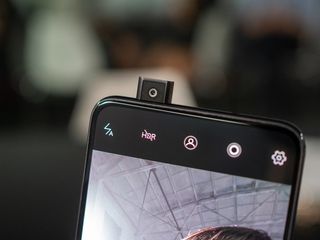Vivo NEX is official with super-thin bezels, pop-up front camera and top-end specs

Vivo showed off a concept phone back at MWC with ultra-thin bezels and a pop-up front camera, and the company has formally unveiled the product in China. The Vivo NEX comes with a 6.59-inch FHD+ 19.3:9 Super AMOLED display that offers a 91.2% screen-to-body ratio, with the company noting that it took several "industry-first" technologies to maximize the screen real estate.
Vivo ditched the standard earpiece in lieu of Screen SoundCasting Technology, which turns the entire screen into a speaker. The tech is similar to what you'd find in bone conduction headsets, and Vivo says it offers more powerful bass and smoother treble, all while enabling the brand to shrink the top bezel.
Vivo NEX hands-on: One step closer to a bezel-less future

Speaking of bezels, the top bezel is just 2.16 mm thick, with the bottom bezel coming in at 5.08 mm and the side bezels at 1.71 mm. The NEX also features a third-generation in-display fingerprint sensor, with the brand stating that the new sensor is 50% better at recognition accuracy with a broader detection area and 10% faster unlock speed.
While the front of the phone gets all the attention, the back isn't all that bad either. The glass back is coated with what Vivo calls "Holographic Diffraction Dynamic Color" illusion technology, which sees thousands of "diffraction units" laser engraved onto the back of the device to create a "dreamlike sci-fi effect."

The phone's pièce de résistance is the retractable 8MP front camera. The module is hidden away in everyday use, and pops up whenever you activate the front camera to take a selfie. It takes just over a second for the module to pop up, and Vivo says that the micro-drive system along with the independent drive ICs allow the camera to elevate with "absolute precision."
The motor can push up to 500 g, withstand a thrust force of 45KG, and can be raised and lowered over 50,000 times. Vivo is basically saying that the module won't break should the phone take a tumble when it is activated.
Be an expert in 5 minutes
Get the latest news from Android Central, your trusted companion in the world of Android



Under the hood, the NEX is powered by a Snapdragon 845 chipset, and it comes with 8GB of RAM and 128GB of internal storage as standard, and you can also pick up a variant with 8GB of RAM and 256GB of storage. There's also a 4000mAh battery, dual 12MP + 5MP cameras at the back (with 4-axis OIS), and the phone runs Funtouch OS 4.0 based on Android 8.1 Oreo. And unlike the Mi Mix 2, the Vivo NEX has a headphone jack.
Vivo is also selling a base variant of the NEX with a Snapdragon 710 along with 6GB of RAM and 128GB of storage, which will be available for ¥3,898 ($610).
Vivo NEX specs
Vivo is touting the AI capabilities of the NEX, with the phone offering AI-assisted scene recognition, HDR, filters, and photo composition. Vivo is also rolling out updates to its China-specific Jovi voice assistant, which can now launch apps and identify objects on a user's screen, à la Bixby Vision.
Vivo's solution for the notch is certainly intriguing (and it looks really cool), but it remains to be seen if the retractable camera works seamlessly in day-to-day usage.
For now, the Vivo NEX is limited to the Chinese market, where the phone will go on sale for the equivalent of $610. The variant with the Snapdragon 845 will retail for ¥4,498 ($700), and the version with 256GB of storage will set customers back ¥4,998 ($780). There's no indication that the device will make its way to global markets, but we'll let you know should that change.
In the meantime, what are your thoughts on the Vivo NEX?
Vivo NEX hands-on: One step closer to a bezel-less future

Harish Jonnalagadda is a Senior Editor overseeing Asia at Android Central. He leads the site's coverage of Chinese phone brands, contributing to reviews, features, and buying guides. He also writes about storage servers, audio products, and the semiconductor industry. Contact him on Twitter at @chunkynerd.